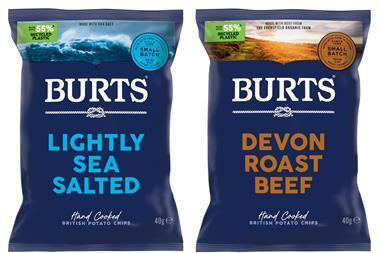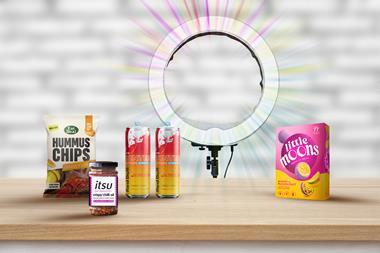What a mess! Over the last fortnight, the press has been awash with stories about the labelling "war" between the FSA's government-endorsed traffic-light labelling scheme and the FDF's front-of-pack GDAs.
Whether the two camps really are at loggerheads - and both sides insist they are not - there's no doubt both are raising their game in their bid to persuade consumers that theirs is the most useful and easy-to-understand scheme.
So which will win out? Will the government allow two to operate side-by-side? Will it back down if there's overwhelming industry support for GDA? Or will it force through legislation in support of traffic lights, as PM Tony Blair has reportedly threatened?
After a long and deafening silence, the momentum appears to be with GDAs. Premier Foods became, this week, the 22nd UK supplier to join the GDA camp, pledging to label £1bn of its lines over the next 12 to 18 months; Kerry Foods is also poised to back front-of-pack GDAs; and we understand Lidl has become the first discounter to do the same. But announcements are expected imminently about more suppliers joining the traffic lights camp.
For all the statements of intent, front-of-pack labelling is still in its infancy. Many manufacturers have yet to show their hand, although most of the UK's biggest brands have now backed GDAs, which have the support of 40% of the market, according to campaign co-ordinator Jane Holdsworth. The retailers, meanwhile are split down the middle.
The situation is further complicated by the plethora of hybrid labels that have emerged, which range from colour co-ordinated GDAs to traffic lights presenting the level of fat, saturated fat, sugar and salt in grams per portion as well as the controversial 100g measure that underpins nutrient profiling. A trip down a supermarket aisle will confirm that most of the support is merely intentional, with plans yet to be put into practice.
Until now, the retailers have been the most vociferous and action-oriented in support of their respective camps, Sainsbury's publishing research claiming GDAs are misleading and Tesco releasing data on GDAs' influence on purchasing behaviour.
That all changed last week. The £4m campaign, Know What's Going Inside You, orchestrated by the FDF, has been hailed as the biggest-ever joint initiative by the industry. But the FSA's 10-second TV campaign breaks later this month. So there's all to play for. Yet the outcome will depend as much on what consumers make of either scheme as on how much pick-up they get. The pan-industry Nutrition Strategy Steering Group, chaired by public health minister Caroline Flint and FSA chair Dame Deirdre Hutton, is working, with help from Unilever's Gavin Neath and PepsiCo's Salman Amin, to evaluate which scheme is more useful to consumers.
A key issue is the scope of the schemes. Traffic-light labelling, which supporters say has greater impact, was originally intended to cover a few categories in processed foods. However, GDA supporters argue their scheme has far wider scope and the more categories traffic lights are applied to, the less relevant the 100g becomes.
"In fairness to the FSA, it initially said it only intended traffic lights for ready meals, pizzas and so on. 100g wasn't a bad choice but when you're looking at a variety of products, it becomes irrelevant and potentially misleading," says Ben Clarke, vice president and area director, Kraft Foods UK and Ireland.
Holdsworth estimates that industry support will rise to "at least 50% by this time next year," and predicts the number of lines carrying the label will increase from 10,000 to 20,000, but won't be drawn on how many suppliers she expects to have signed up by that point, saying it is more an issue of consumer take-up. "It's not about critical mass. I'd rather 70% to 80% of consumers know about the scheme and are using it."
Both camps insist they'll go with whatever the consumer prefers and if that means both schemes, so be it.
The debate dominated proceedings at a round table discussion supposedly about sustainability and food ethics this week. Dame Deirdre Hutton was reportedly fairly sanguine about manufacturers' support for GDAs, arguing she would go with whatever proved best for consumers.
Holdsworth takes a similar line and adds that though it wouldn't be ideal, there is no reason why both schemes couldn't coexist. "People can manage with two systems. There's enough similarity between the two."
Both agree legislation is unlikely. Labelling falls under EU law and therefore Brussels would have to pass new laws first if any changes were to be made in the UK. Owen Warnock, food law specialist at Eversheds, says: "Front-of-pack labelling interferes with free trade in Europe. The European court would probably say adequate signage was given via labelling on back of pack." It could even be argued that front-of-pack labelling breaks the law, he says. "If it legislated, the government would have to demonstrate it was in the interests of public health. I'm not sure it would have a strong enough case."
The NSSG meets again on 23 January to discuss the best way of evaluating the effectiveness of the various schemes on the market.
The GDA camp remains confident its scheme will be the industry choice. But it seems the consumer will decide who's the winner. Or it may just opt for both.The two schemes
When the FSA first published details of its traffic-light labelling scheme in 2005, The Grocer warned it wouldn't go down well with much of the industry, and it hasn't.
The FSA's traffic lights identify whether products are high, medium or low in fat, saturated fat, salt and sugars. The measures are underpinned by the nutrient profiling model, which identifies how many grams per hundred - though retailers and suppliers have adapted the measure to show grams per pack or portion size. Some hybrid schemes, such as Sainsbury's Wheel of Health, also colour-code calorie content.
Under the Know What's Going Inside You GDA scheme, labels identify HFSS content of a typical portion as a percentage of the Guideline Daily Amount. Some supporters have opted for colour-coded schemes in a nod to traffic lights.The two camps
GDA scheme supporters
Associated British Foods, AG Barr, Birds Eye, Britvic, Coca-Cola, Cadbury Schweppes, Calypso, Danone, Gerber, GlaxoSmithKline Consumer Healthcare, Kellogg, Kraft, Masterfoods, Morrisons, Nestlé, PepsiCo, Premier Foods, Shloer, Somerfield,
Sunny D, Tate & Lyle, Tesco, Unilever, Vimto, Warburtons.
Tesco
The retailer has labelled more than 5,000 products and is committed to labelling all its own-label products by the spring.
Morrisons
2,500 lines now carry front-of-pack GDA labels.
Somerfield
Front-of-pack GDAs feature on 70% of own label.
Premier Foods
Premier is expected to roll out front-of-pack GDAs to £1bn of its lines in the next 12 to 18 months.
Kerry Foods
The manufacturer plans to bring its Golden Vale Cheestrings brand under the GDA labelling system later this year as part of a pack revamp.
Lidl
The discounter is understood to be rolling out front-of-pack GDAs to a range of lines, including dairy, premium snacks and cereal.
Traffic light supporters
Asda, Budgens, co-ops, Londis, McCain, Marks & Spencer, New Covent Garden Food Company, Sainsbury's, Waitrose.
Sainsbury's
Its Wheel of Health, launched two years ago, now features on 4,000 lines. This month it went on 250 of its value "basics" range.
Asda
The retailer is committed to "a common-sense, cross-industry approach ... using colour-coding coupled with GDAs". There are currently no products on shelves with the new labelling but it plans to launch a trial in the next couple of months.
M&S
The retailer's Eat-Well sunflower logo is on 1,000 products. It plans to "take the best of both worlds" and from the end of the month will use colour-coded GDAs on a third of its ready meals. A further 400 lines included in the FSA's list of recommended categories will be labelled later this year.
Waitrose
The retailer has said it will extend traffic lights to all recommended food categories by the end of March.
Whether the two camps really are at loggerheads - and both sides insist they are not - there's no doubt both are raising their game in their bid to persuade consumers that theirs is the most useful and easy-to-understand scheme.
So which will win out? Will the government allow two to operate side-by-side? Will it back down if there's overwhelming industry support for GDA? Or will it force through legislation in support of traffic lights, as PM Tony Blair has reportedly threatened?
After a long and deafening silence, the momentum appears to be with GDAs. Premier Foods became, this week, the 22nd UK supplier to join the GDA camp, pledging to label £1bn of its lines over the next 12 to 18 months; Kerry Foods is also poised to back front-of-pack GDAs; and we understand Lidl has become the first discounter to do the same. But announcements are expected imminently about more suppliers joining the traffic lights camp.
For all the statements of intent, front-of-pack labelling is still in its infancy. Many manufacturers have yet to show their hand, although most of the UK's biggest brands have now backed GDAs, which have the support of 40% of the market, according to campaign co-ordinator Jane Holdsworth. The retailers, meanwhile are split down the middle.
The situation is further complicated by the plethora of hybrid labels that have emerged, which range from colour co-ordinated GDAs to traffic lights presenting the level of fat, saturated fat, sugar and salt in grams per portion as well as the controversial 100g measure that underpins nutrient profiling. A trip down a supermarket aisle will confirm that most of the support is merely intentional, with plans yet to be put into practice.
Until now, the retailers have been the most vociferous and action-oriented in support of their respective camps, Sainsbury's publishing research claiming GDAs are misleading and Tesco releasing data on GDAs' influence on purchasing behaviour.
That all changed last week. The £4m campaign, Know What's Going Inside You, orchestrated by the FDF, has been hailed as the biggest-ever joint initiative by the industry. But the FSA's 10-second TV campaign breaks later this month. So there's all to play for. Yet the outcome will depend as much on what consumers make of either scheme as on how much pick-up they get. The pan-industry Nutrition Strategy Steering Group, chaired by public health minister Caroline Flint and FSA chair Dame Deirdre Hutton, is working, with help from Unilever's Gavin Neath and PepsiCo's Salman Amin, to evaluate which scheme is more useful to consumers.
A key issue is the scope of the schemes. Traffic-light labelling, which supporters say has greater impact, was originally intended to cover a few categories in processed foods. However, GDA supporters argue their scheme has far wider scope and the more categories traffic lights are applied to, the less relevant the 100g becomes.
"In fairness to the FSA, it initially said it only intended traffic lights for ready meals, pizzas and so on. 100g wasn't a bad choice but when you're looking at a variety of products, it becomes irrelevant and potentially misleading," says Ben Clarke, vice president and area director, Kraft Foods UK and Ireland.
Holdsworth estimates that industry support will rise to "at least 50% by this time next year," and predicts the number of lines carrying the label will increase from 10,000 to 20,000, but won't be drawn on how many suppliers she expects to have signed up by that point, saying it is more an issue of consumer take-up. "It's not about critical mass. I'd rather 70% to 80% of consumers know about the scheme and are using it."
Both camps insist they'll go with whatever the consumer prefers and if that means both schemes, so be it.
The debate dominated proceedings at a round table discussion supposedly about sustainability and food ethics this week. Dame Deirdre Hutton was reportedly fairly sanguine about manufacturers' support for GDAs, arguing she would go with whatever proved best for consumers.
Holdsworth takes a similar line and adds that though it wouldn't be ideal, there is no reason why both schemes couldn't coexist. "People can manage with two systems. There's enough similarity between the two."
Both agree legislation is unlikely. Labelling falls under EU law and therefore Brussels would have to pass new laws first if any changes were to be made in the UK. Owen Warnock, food law specialist at Eversheds, says: "Front-of-pack labelling interferes with free trade in Europe. The European court would probably say adequate signage was given via labelling on back of pack." It could even be argued that front-of-pack labelling breaks the law, he says. "If it legislated, the government would have to demonstrate it was in the interests of public health. I'm not sure it would have a strong enough case."
The NSSG meets again on 23 January to discuss the best way of evaluating the effectiveness of the various schemes on the market.
The GDA camp remains confident its scheme will be the industry choice. But it seems the consumer will decide who's the winner. Or it may just opt for both.The two schemes
When the FSA first published details of its traffic-light labelling scheme in 2005, The Grocer warned it wouldn't go down well with much of the industry, and it hasn't.
The FSA's traffic lights identify whether products are high, medium or low in fat, saturated fat, salt and sugars. The measures are underpinned by the nutrient profiling model, which identifies how many grams per hundred - though retailers and suppliers have adapted the measure to show grams per pack or portion size. Some hybrid schemes, such as Sainsbury's Wheel of Health, also colour-code calorie content.
Under the Know What's Going Inside You GDA scheme, labels identify HFSS content of a typical portion as a percentage of the Guideline Daily Amount. Some supporters have opted for colour-coded schemes in a nod to traffic lights.The two camps
GDA scheme supporters
Associated British Foods, AG Barr, Birds Eye, Britvic, Coca-Cola, Cadbury Schweppes, Calypso, Danone, Gerber, GlaxoSmithKline Consumer Healthcare, Kellogg, Kraft, Masterfoods, Morrisons, Nestlé, PepsiCo, Premier Foods, Shloer, Somerfield,
Sunny D, Tate & Lyle, Tesco, Unilever, Vimto, Warburtons.
Tesco
The retailer has labelled more than 5,000 products and is committed to labelling all its own-label products by the spring.
Morrisons
2,500 lines now carry front-of-pack GDA labels.
Somerfield
Front-of-pack GDAs feature on 70% of own label.
Premier Foods
Premier is expected to roll out front-of-pack GDAs to £1bn of its lines in the next 12 to 18 months.
Kerry Foods
The manufacturer plans to bring its Golden Vale Cheestrings brand under the GDA labelling system later this year as part of a pack revamp.
Lidl
The discounter is understood to be rolling out front-of-pack GDAs to a range of lines, including dairy, premium snacks and cereal.
Traffic light supporters
Asda, Budgens, co-ops, Londis, McCain, Marks & Spencer, New Covent Garden Food Company, Sainsbury's, Waitrose.
Sainsbury's
Its Wheel of Health, launched two years ago, now features on 4,000 lines. This month it went on 250 of its value "basics" range.
Asda
The retailer is committed to "a common-sense, cross-industry approach ... using colour-coding coupled with GDAs". There are currently no products on shelves with the new labelling but it plans to launch a trial in the next couple of months.
M&S
The retailer's Eat-Well sunflower logo is on 1,000 products. It plans to "take the best of both worlds" and from the end of the month will use colour-coded GDAs on a third of its ready meals. A further 400 lines included in the FSA's list of recommended categories will be labelled later this year.
Waitrose
The retailer has said it will extend traffic lights to all recommended food categories by the end of March.



















No comments yet